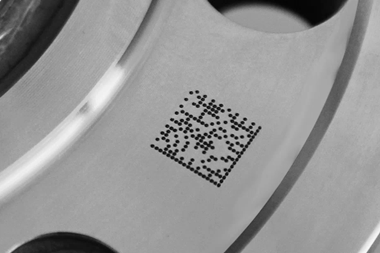
A Data Matrix code (DMC) is applied to many brake discs once they have been coated by Sprimag’s Coating Systems, making workpieces clearly identifiable and aiding the assembly process
Although laser marking was once the preserve of high-performance brake discs in the premium sports car sector, it has now become an established practice and is applied for a wide variety of automotive manufacturers.
Nill+Ritz is a leading system partner for these sophisticated marking systems – whether dot peen markers, scribing machines, laser markers or engraving equipment. The latest fully and semi-automatic machines are used together with in-line production solutions to mark all manner of components, including not only brake discs but also crankshafts, gears and wheel hubs.
The company is Sprimag’s cooperation partner in this field and has developed a laser-marking system for use in fully automated production lines, which applies a Data Matrix code and alphanumerical plain text to the brake discs for the purposes of clear labelling. This is done in a marking station after the coating process. Not only does this mean the brake discs are always traceable, but it also ensures that the correct brake disc reaches the correct axis during the subsequent assembly at the manufacturer’s plant.
In order to integrate this type of marking system into Sprimag’s automatic coating systems, a variety of solutions are available, tailored to the specific machine design, output or component. One aspect that is also of critical importance to this integration process is a data interface that ensures the consistency of customer-specific and part-specific production data.
This exemplary laser-marking station is used to perform technically demanding process steps, with a brake disc reaching the marking station via a roller conveyor. Because of the short cycle times, the brake disc remains in a location within the laser station that is not precisely defined. A camera, mounted on the third axis positioning system, locates the workpiece, identifies the position and orientation of the hole pattern, and looks for the index hole. This enables the positioning system, controlled by a servo drive, to guide the laser to the precise position for marking. The pneumatically driven lift gates on the inlet and outlet form a light-tight seal around the laser safety cabin, and a Data Matrix code and plain text are lasered on to the disc. Once the marking is complete, another camera, mounted on the positioning system, reads the code and checks the quality of the code in accordance with a defined standard. Once successfully scanned, the brake disc is moved on to the packing station, where it is subject to one final visual check before making its onward journey to one of the many assembly facilities around the world.
Andreas Bechtold, sales manager at Nill+Ritz, explains how the market has evolved in recent years: “The use of lasers in industrial settings is expanding. Operators are utilising laser technology in a growing number of applications, in order to perform individual manufacturing tasks more effectively and efficiently. This trend is also strengthened by the new robust lasers (and laser systems) that are easy to integrate into production lines. Never in the history of laser technology have lasers been as safe and simple to use as they are today. At the same time, there has been a major shift in who is using lasers, with customers now demanding straightforward, hard-wearing lasers that they can easily learn to use.”
Despite the greater use of laser marking, Bechtold thinks that dot peen marking still has a future. “The key advantages of dot peen marking are the small initial investment and the durable marking of the products, such as on brake discs,” he confirms. “Because the indentation is only applied to the surface, it does not damage the products or impair them in any other way.”
Machine-readable codes like the Data Matrix code have their advantages, though: “The DMC marking allows the manufacturer to trace parts back through the entire production process, as well as through the entire supply chain,” he adds. “The technology is ideal for keeping track of parts that require maintenance or are subject to recalls, plus it is also useful when dealing with liability or warranty claims. 2D codes allow more information to be stored in a small space using a variety of direct marking methods.”
www.sprimag.com






































